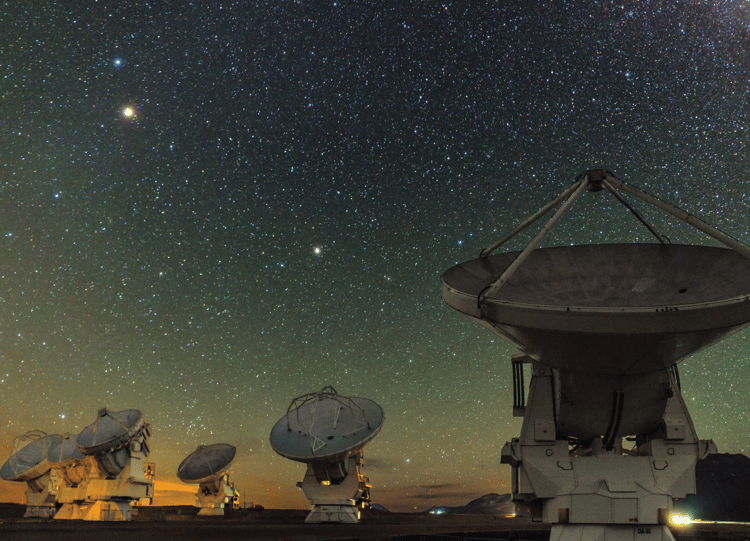What is the collaborative atmosphere like at ESO? How do teams from different disciplines work together on projects?
ESO staff members are all motivated and driven by the ESO vision of advancing humanity’s understanding of the Universe by working with and for the astronomy community, providing it with world-leading facilities. In addition, ESO is promoting actively a respectful working place policy with personal values and attitudes like respect, integrity, accountability, commitment, collaboration and clear & open communication.
In more details, all our projects are multi-disciplinary. A project is led by a Project Manager (in charge of the planning, budget and coordination of the team), a Project Scientist (in charge of keeping the scientific objectives at the focus of the system and of planning its scient5ific verification, operation and calibration) and a System Engineer (in charge of the architectural design of the system to meet the scientific objectives, of all the interfaces and of the verification of the system performance). The rest of the team is composed of engineers and specialists of each discipline (mechanics, optics, electronics, software, control, data reduction…). In internal projects, the team members design, manufacture, and install the parts they are in charge of. In projects led by external Consortia (of research institutes) or by industrial contractors, the team reviews the design and products delivered by the partners. When it is time to deliver the system to the observatory, all team members work together in Chile to install, verify and bring it to operation.
A close collaboration with an open communication between all team members is essential to the success. As an international organisation with the headquarters in Germany, the observatories in Chile and collaborations with institutes and industries in many European countries, Chile, US, Japan and Australia, we have all to adapt to other ways of working than one’s own. Adaptability to different kinds of projects (internal / Consortia / industry, small / (very) big, R&D / prototype / production…) is also important. The coordination of the activities is organised through regular team meetings, progress meetings and/or so-called “busy weeks”.
What are some of the biggest challenges and future directions ESO is facing, and how can new recruits contribute to these?
The biggest challenge in the next 5 to 10 years is the integration and bringing in operation of the Extremely Large Telescope, currently under construction, while keeping our other observatories at the top of their field. Combining such a mega-project with smaller but essential upgrades and new developments on the existing telescopes is not easy.
The integration of the ELT will need a large team working in shifts, 7 days a week, 12 to 24 hours a day, during a couple of years, at 3000m altitude, in the middle of the desert.
New recruits, full of energy and motivation, eager to work in exceptional conditions, are essential to the success of the ELT. They have to be ready to jump in the train, to learn from the current team, to help solve the issues – that will certainly happen – with fresh ideas, and to bring astronomical telescopes and instruments to the next level of performance, automation, maintenance and data mining. Young-minded people, affine to new technologies and new ways of working, can bring a lot when combined with the long experience and large know-how accumulated at ESO.
Are there opportunities for employees to work on projects with international partners?
ESO is by essence an international organisation. The fact that ESO is now the leading ground-based observatory in the world would not have been possible without the strong involvement and tight collaboration of European, Chilean, Australian research institutes (universities and national observatories) and industries to ESO projects. All ESO projects, even the smallest ones, involve international collaborations and meetings. Our astronomical database is open to any researcher worldwide and our astronomers are part of international research collaborations and networks, participating to and organising international conferences regularly.
Describe ESO's commitment to diversity and inclusion in its workforce and research collaborations. What are some current actions being taken
ESO holds sustainability and diversity at the core of its organisational values. In line with this commitment, ESO established the Quality and Sustainability Office tasked with crafting and overseeing the implementation of ESO’s Sustainability Strategy and Diversity, Equity, and Inclusion (DEI) Plan.
ESO views the promotion of Diversity, Equity, and Inclusion (DEI) as crucial for social cohesion and meeting the needs of future generations, similar to the imperative of caring for the environment. For this reason, the DEI Plan is an integral part of ESO’s sustainability strategy.
Current initiatives:
Current DEI initiatives focus on promoting the conditions to increase diversity and nurturing the conditions for inclusion.
We are currently reviewing our hiring process and pay structure to understand the source of potential biases and taking measures to correct those. Currently, at 26%, our DEI Plan aims to reach a female representation of 30% by 2030, with an emphasis on engineering and decision-making positions.
ESO is putting in place a support network for people with disabilities to promote a work environment where they feel understood, welcome, and can make use of their full potential.
Together with UN Women, ESO makes use of its professional training programs to promote science and engineering among women and young women, aiming at increasing female participation in STEM-related activities. By doing so, ESO and UN Women empower women by increasing their employability in male-dominated and high-added-value economic sectors, with a special focus on the communities close to the ESO site in Northern Chile.
ESO is an active member of EIROForum, collaborating with other International Organisations in sustainability and in promoting DEI.
Find jobs at ESO
